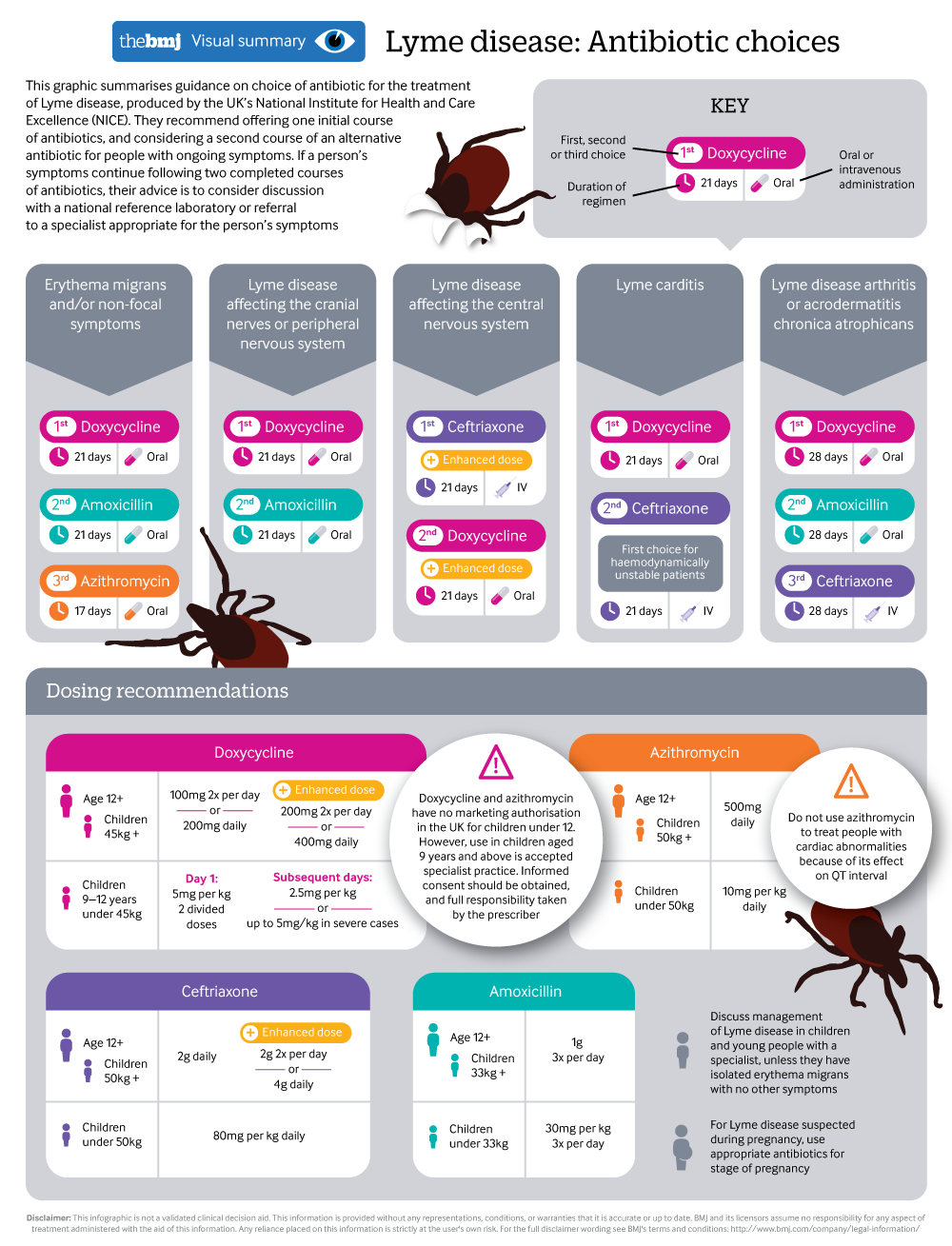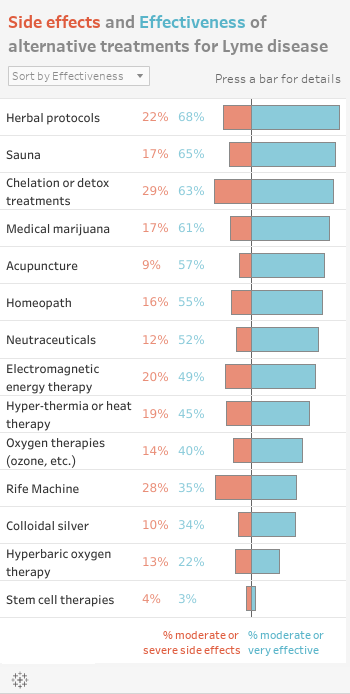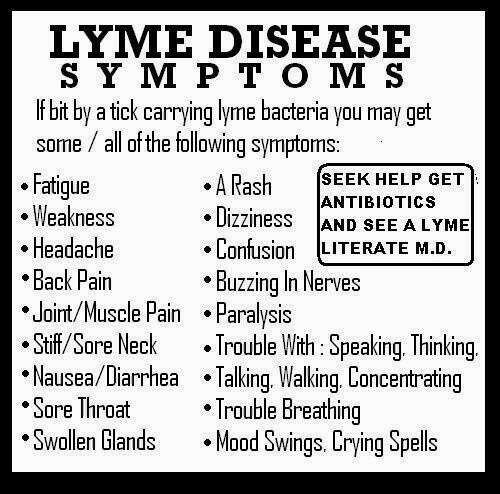What Are The Risk Factors For Post Treatment Lyme Disease
Risk factors for Post Treatment Lyme Disease include:
- Delay in diagnosis
- Increased severity of initial illness
- Presence of neurologic symptoms
Increased severity of initial illness, the presence of neurologic symptoms, and initial misdiagnosis increase the risk of Post Treatment Lyme Disease. PTLD is especially common in people that have had neurologic involvement. The rates of Post Treatment Lyme Disease after neurologic involvement may be as high as 20% or even higher. Other risk factors being investigated are genetic predispositions and immunologic variables.
In addition to Borrelia burgdorferi, the bacteria that causes Lyme disease, there are several other tick-borne co-infections that may also contribute to more prolonged and complicated illness.
Antimicrobials That Kill Growing Phase Spirochetes
Extracellular
Penicillins
- Amoxicillin 500 mg 1 to 2 pills 3 times a day. Alternatively as an alternative to IV antibiotics take 3 to 4 pills 3 times a day.
- Amoxicillin/Clavulanic Acid 875 mg/125 mg 1 pill 2 times a day
- Bicillin LA 2.4 million units IM 3 times a week with one day between each injection
Cephalosporins
- Ceftriaxone 2 gm IV 2 times a day for 4 days in a row then off for 3 days of each 7 days
- Cefotaxime 2 gm IV every 8 hours
- Cefuroxime 500 mg 1 pill 2 times a day
- Cefdinir 300 mg 1 pill 2 times a day
Additional IV Antibiotics
Vancomycin, imipenem, and ertapenem are possible alternatives if someone is allergic to Ceftriaxone or Cefotaxime.
Intracellular and Extracellular
- Clarithromycin 500 mg 2 pills 2 times a day
- Azithromycin 500 mg 1 time a day or 500 mg IV 1 time a day
Tetracyclines
- Doxycycline 100 mg 1 or 2 pills 2 times a day or 200 to 400 mg mg IV 1 time a day
- Minocycline 100 mg 1 pill 2 times a day
Azlocillin Comes Out On Top
The drug, which is not on the market, was tested in mouse models of Lyme disease at seven-day, 14-day and 21-day intervals and found to eliminate the infection. For the first time, azlocillin was also shown to be effective in killing drug-tolerant forms of B. burgdorferi in lab dishes, indicating that it may work as a therapy for lingering symptoms of Lyme disease.
Pothineni and Rajadas have patented the compound for the treatment of Lyme disease and are working with a company to develop an oral form of the drug. Researchers plan to conduct a clinical trial.
Rajadas is also a professor of bioengineering and therapeutic sciences at the University of California-San Francisco.
Other Stanford co-authors are Hari-Hara S. K. Potula, PhD, senior research scientist postdoctoral scholars Aditya Ambati, PhD, and Venkata Mallajosyula, PhD senior research scientist Mohammed Inayathullah, PhD and intern Mohamed Sohail Ahmed.
A researcher at Loyola College in India also contributed to the work.
The study was funded by the Bay Area Lyme Foundation and Laurel STEM Fund.
- Tracie White
Also Check: Do Ticks In Florida Carry Lyme Disease
What Is Late Lyme Disease
Lyme disease, also known as Lyme borreliosis, is caused by an infection with the bacteria Borrelia burgdorferi. This bacteria is disseminated through tick bites. Infected ticks usually bite small mammals, who do not develop any kind of infection from the bacteria. When humans are exposed to B. Burgdorferi from a tick bite, however, they can develop Lyme disease.
People who work outside or spend time in woodland areas, where there is greater potential for exposure to tick bites, are most at risk of infection.
Lyme disease is a condition which progresses in stages:
Treating Early Stage Lyme Disease

The early stages of Lyme disease usually include the bull’s-eye rash and flu-like symptoms of chills and fever, fatigue, muscle pain, and headache. In rare cases, people develop an abnormal heartbeat .
All of these conditions are treated with 14 to 28 days antibiotics courses. The exact number of days depends on the drug used and the person’s response to it. Antibiotics for treating Lyme disease generally include:
- Doxycycline. This antibiotic is effective against both Lyme disease and human granulocytic anaplasmosis . It is the standard antibiotic for anyone over 8 years old, except for pregnant women. It is a form of tetracycline and can discolor teeth and inhibit bone growth in young children. It can also cause birth defects if used during pregnancy.
- Amoxicillin. This type of penicillin is probably the best antibiotic for pregnant women. Some people are allergic to penicillin and strains of Lyme bacteria are emerging that are resistant to it.
- Cefuroxime . This cephalosporin antibiotic is an alternative treatment for young children and for adults with penicillin allergy.
- Intravenous ceftriaxone or cefotaxime. Intravenous infusions of one of these cephalosporin antibiotics may be warranted if there are signs of infection in the central nervous system or heart.
Other types of antibiotics, such as macrolides like azithromycin and clarithromycin, are not recommended for first-line therapy.
Antibiotic Side Effects
Don’t Miss: Snow Plowing East Lyme Ct
Sample Selection And Cohort Identification
Patients were identified for the sample using International Classification of Diseases, Ninth Revision codes and International Classification of Diseases, Tenth Revision codes on medical claims Healthcare Common Procedure Coding System codes for IV medications on medical claims and generic product names for oral antibiotics, obtained by matching National Drug Code numbers on pharmacy claims to the Truven Red Book. The sample was designed a priori to represent patients who were initially treated for Lyme disease using a recommended antibiotic regimen were diagnosed with PLDS 6 months after the initial diagnosis and were, for the PLDS, either treated with IV antibiotics, with or without oral antibiotics , treated with oral antibiotics, without IV antibiotics , or not treated with antibiotics . Combinations of IV and oral treatments were included in cohort 1 to maximize power to detect IV-related adverse effects, especially in patients receiving multiple pharmacotherapies, a concern highlighted in the CDC report .
Tetracycline Plus Rifamycin Plus Disulfiram
- minocycline 100 mg 1 pill 2 times a day
- rifampin 300 mg 2 pills 1 time a day
- disulfiram 4 to 5 mg/ kg body weight. Work up to this dose slowly over 2 months then remain on the disulfiram at the peak dose for 4 months before tapering off.
Key Points:
- This minocycine and rifampin in this combination are as useful for treating a Bartonella co-infection. Co-infections are other germs passed on during a tick bite. If someone has a co-infection, when possible I choose antibiotic combinations that simultaneously treat Lyme germs and the co-infection germs.
- The disulfiram is added here to treat persister Lyme. Note disulfiram does not appear to treat Bartonella.
You May Like: Symptoms Of Lyme Disease In Dogs
How To Prevent Post
While you may not be able to prevent post-treatment Lyme disease syndrome, you can take precautions to prevent coming into direct contact with infected ticks. The following practices can reduce your likelihood of getting Lyme disease and developing persistent symptoms.
If a tick bites you, contact your doctor. You should be observed for 30 days for signs of Lyme disease. You should also learn the signs of early Lyme disease and seek prompt treatment if you think youre infected. Early antibiotic intervention may reduce your risk of developing chronic symptoms.
The signs of early Lyme disease can occur from 3 to 30 days after a bite from an infected tick. Look for:
- a red, expanding bulls-eye rash at the site of the tick bite
Stage : Early Disseminated Lyme Disease
Early disseminated Lyme disease occurs several weeks to months after the tick bite.
Youll have a general feeling of being unwell, and a rash may appear in areas other than the tick bite.
This stage of the disease is primarily characterized by evidence of systemic infection, which means infection has spread throughout the body, including to other organs.
Symptoms can include:
- disturbances in heart rhythm, which can be caused by Lyme carditis
- neurologic conditions, such as numbness, tingling, facial and cranial nerve palsies, and meningitis
The symptoms of stages 1 and 2 can overlap.
Read Also: What Type Of Doctor Treats Lyme Disease
Iv Antibiotic Regimen: Cephalosporin Plus Azole Plus Liposomal Cinnamon Clove And Oregano
- ceftriaxone 2 gm IV 2 times a day for 4 days on and 3 days off
- tinidazole 500 mg taken orally 1 pill 2-3 times a day for 4 days on and 3 days off in 7-day cycles
- liposomal cinnamon, clove, and oregano capsules 1 pill 2 times a day
Key Points:
- Various antibiotics can be used as IV. I use this one most commonly because it is the easiest to administer and one of the lowest cost IV regimens. The ceftriaxone is given in a syringe and injected over 10 minutes. This is also a pulse dose regimen . Ceftriaxone could be given daily instead as 2 gm IV 1 time a day.
- I have found various pulse dose regimens of tinidazole to work. These include 2 weeks on and 2 weeks off or in the regimen seen here.
What To Try If You Have Failed Years Of Antibiotics
In my practice for those that have failed years of regular antibiotics I offer two persister oriented regimes. Both of these regimens have some published clinical evidence of benefit. One regimen I offer is a Horowitz dapsone persister regimen. The other option I offer is a disulfiram only regimen or a disulfiram combination regimen . You can read more details about how to take both of these regimens in
Recommended Reading: Ozone Therapy For Chronic Lyme
Will Prescription Antibiotics Work Faster Or Better Than Natural Antibiotics For Lyme
Unfortunately, from nearly a decade of experience my answer is no. Antibiotics are extremely effective if taken within the first 3 months of contracting Lyme. Doing antibiotic regiments for patients with chronic Lyme does not work faster than natural methods. In fact, from my experience heavy prescription antibiotic methods cause a plethora of messy and harsh side effects. In the 20% of patients who require medical antibiotics to recover we spend much of our time trying to counteract the negative and unpleasant side effects the prescription is causing.
Do Antibiotics Cure Lyme Disease

As of 2018, there is no cure for Lyme disease and no definitive test to see if you are cured. Although some strains respond positively to antibiotics in early stages, one size does not fit all.
The pathogen can also reappear even after this type of treatment because Lyme disease is difficult to categorize, due to its multifaceted nature and treatment specialization in most doctors.
Even if a physician has working knowledge of Lyme disease, antibiotics arent always 100 percent effective. However, there are alternative treatment options besides antibiotics, often geared toward management and improving quality of life overall.
Recommended Reading: Different Tests For Lyme Disease
What Did This Study Do
This network meta-analysis included 19 randomised controlled trials involving 2,532 people with erythema migrans due to Lyme disease. No trials were based in the UK most were from the United States or Europe.
Each trial compared two or three antibiotics. Doxycycline was the most frequently used antibiotic. A number of doses and treatment durations were represented. For example, treatment length for doxycycline ranged from 10 to 21 days. For the main analyses, doxycycline was used as the reference treatment.
Both direct and indirect data were extracted from the studies. This approach is helpful when there is a shortage of head to head research, but this, and the overall low quality of included studies means that results need to be treated with some caution.
Macrolide Plus Quinine Derivative Plus Azole Plus Methylene Blue
- azithromycin 500 mg 1 pill 1 time a day
- hydroxychloroquine 200 mg 1 pill 2 times a day
- metronidazole 500 mg 1 pill 2 or 3 times a day
- methylene blue 50 mg 2 times a day
Key Points:
- Since azithromycin is not as effective as other macrolides like clarithromycin, hydroxychloroquine is used to increase the effectiveness.
- Tinidazole could be substituted for the metronidazole because it may remove biofilms more effectively.
- Methylene Blue can treat persister Lyme.
Don’t Miss: Can You Die From Lyme Disease
Antimicrobial Herbs That Kill Growing Phase Spirochetes & Cysts
Intracellular and Extracellular
Based on my observations, these herbal combination options have as good of a chance as the prescription options. They appear to kill intracellular and extracellular Lyme too based on the clinical benefit I see in my medical practice.
- Cats Claw and Otoba Bark Tinctures 30 drops of each 2 times a day. Start at 5 drops 2 times a day and add 1 drop per dose per day until you reach 30 drops 2 times a day. If you get a Herxheimer reaction, stop increasing the dose until it has passed.
- Cats Claw and Japanese Knotweed 30 drops of Cats Claw 2 times a day and ½ tsp of Japanese Knotweed 3 times a day. Work up to these doses over 30 days. Start Cats Claw at 5 drops 2 times a day and add 1 drop per dose per day until you reach 30 drops 2 times a day. Start the Japanese Knotweed at ¼ tsp 3 times a day and in two weeks increase to ½ tsp 3 times a day.
Antimicrobials That Kill Growing Phase Cysts
Intracellular and Extracellular
Note: I work with the following agents as anti-cyst agents based on the mechanism by which these antibiotics work and some scientific experiments. For the Rifamycins, there are no laboratory experiments showing these agents work against cysts. Clinically, I see great benefit in using the Rifamycins as my anti-cyst agents – so I list them here.
Rifamycins
- Rifampin 300 mg 2 pills 1 time a day or 1 pill 2 times a day
- Rifabutin 150 mg 2 pills 1 time a day
Azoles
- Tinidazole 500 mg 1 pill 2 or three times a day usually pulsed for four days on then three days off of each 7 days
- Metronidazole 500 mg 1 pill 2 or three times a day usually pulsed for four days on then three days off of each 7 days.
Herbal
- Grapefruit seed extract 250 mg 1 pill 2 times a day. Note this is an herbal antibiotic that I find as effective as the prescription options in this list.
You May Like: Lyme Disease And Massage Therapy
Design And Data Source
The study was a retrospective cohort analysis of medical and pharmacy claims derived from the Truven Health Market Scan Commercial Claims and Encounters Database for calendar years 20132015. The database includes de-identified claims and eligibility information for up to 50 million enrollees each year, covered by commercial health plans and employers located throughout the United States. All diagnoses identified for the present study were based on any of the first 4 diagnosis fields on claims for all settings, plus principal diagnosis and diagnosis-related group codes on inpatient hospital claims .
What Causes Lyme Disease
People get Lyme disease when they are bitten by an infected tick. Ticks live in areas with a lot of plant life, such as wooded areas or fields. They sit near the top of grassy plants and low bushes. They wait there for people or animals to brush up against them. Ticks can crawl on your clothes or body for up to several hours or more before attaching to the skin.
Ticks can attach to any part of your body. They are usually found in hard-to-see areas, including the armpits, groin, or scalp. An infected tick needs to be attached to your skin for 36 to 48 hours before it passes the bacteria on to you.
People who spend time in outdoor areas where ticks are common are at higher risk of getting tick-borne diseases.
Don’t Miss: Costco Pharmacy East Lyme Ct
Questions To Ask Your Doctor
- I found a tick embedded in my skin, but I cant get it out. What should I do?
- Ive been bitten by a tick. Do I need to be seen?
- Do I need a blood test to confirm Lyme disease?
- Which antibiotic is best for me?
- How long will I have to take the antibiotic?
- What tick or insect repellent should I use for me or my child?
- How long will the symptoms last?
- What should I do if I still dont feel well a long time after I was bitten?
How To Use Antibiotics

The standard treatment duration is between 10-28 days, but there tends to be a fairly large relapse rate for those who are deemed as “cured” after the round of antibiotics.1 Additionally, there are many for whom this traditional treatment path does not produce curative results, and many people continue to have spirochete loads that stay in their bodies regardless of treatment regime or symptom reduction.1
Continual antibiotic use for Lyme disease patients can compromise the body’s innate immune function, leaving the host more susceptible to other infection or less-able to combat internal conditions. This is because repeated antibiotic use alters the initial gut flora by killing off both the beneficial bacteria along with the infectious bacteria, leaving the system compromised.1
Read Also: Do You Get A Rash With Lyme Disease